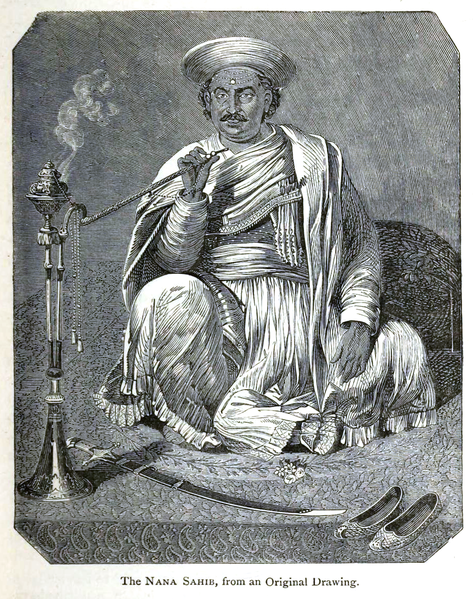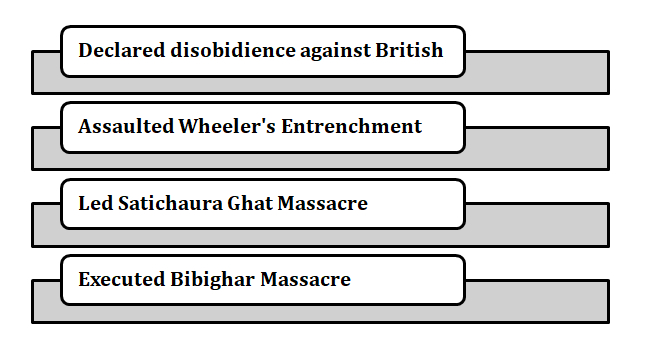

Nana Saheb mainly believed that the East-India Company gave him a pension. Though it was most probably refused by him after his father’s death the Britishers first refused to help him in that period. Later, Nana Saheb inherited the palace of Bithur which is located in Uttar Pradesh. Many high-handed policies and tuff burdens that came into his life made him decide to become a rebel. He was forced to surrender himself in the state of Kanpur.

Nana Saheb
Charles Forjett, Public domain, via Wikimedia Commons
Nana Saheb was mainly adopted by the last emperor of Peshwa and his mother was the Sister-in-law. He was an educated nobleman of the Hindu religion. After that, he grew up he became friends with Tantiya Tope and Rani Laxmi Bai. The second Baji Rao lived in Bithur during the third Anglo-Maratha war. After the battle, he was given some amount of Pension by the EIC. After the death of the last ruler of Peshwa, the British government denied giving him any sort of help from them. They refused to accept the fact that the new emperor was Nana Saheb and stated that he was the heir of the Second Baji Rao.
Nana Saheb was born in the Kanpur district of Uttar Pradesh in May 1824. His father became the official member of the court after he travelled to the court of the second Baji Rao. When Nana Saheb’s father adopted him he gained a pension of 80,000 dollars from the British government which later on proved to be useful for them as Nana Saheb became the governor-general of India.
Later on, after working there for a few days he sent an agent whose name was Azimullah Khan to push his claims to the court of London. But, there his claims were refused due to which they had to face a failure. One of his agents Azimullah Khan told him that when he reached London the British militants were unimpressed by him. After hearing, that Nana Saheb made a crucial decision to join the Kanpur army in June 1857.

Involvement of Nana Saheb in the Indian freedom struggle
Nana Saheb first of all sent Sir Hugh Wheeler the commander of the British force with a message about the upcoming attacks. Safe conduct was given by Nana Saheb under the commander of the British force Huge Wheeler.
Nana Saheb' was broken down as many British citizens who used to support him were destroyed. Later on, he promised the British government that with his 1500 soldiers he would be ready to protect them .
On June 5 1857 the British soldiers took shelter at a safe place. After all the powers they had to resist from the attack that was held at Kanpur. After all sorts of massacres that happened there he as well as the British soldiers went to the safe house that was constructed by the British.
There are many incidents of the Satichaura Ghat that were related to Nana Saheb
The Satichaura Ghat was very unsafe at that time of the war so most of the victims were told to shift from there to Allahabad.
Many boats were asked to be arranged for the shifting process. They requested many people to arrange those boats on the river ‘Ganga as quickly as possible for departure.
When the people were travelling on the boats many of Nana Saheb’s loyal men started firing on them due to which many men and women were killed.
Later when they found that most of the people were alive the soldiers imprisoned them and took them to Bibighar.
This type of incident was known as the Satichaura Ghat massacre.
The Bibighar incident was also one of the most dangerous incidents in the history of Nana Saheb.
Many women and children were taken to Bibighar.
They were mainly used as baits for the British for capturing Nana Saheb. When the plan for capturing Nana Saheb directly they indirectly executed the plan.
Many dead bodies of most of the women and children were thrown away into a nearby well.
Due to the orders, the women and children were brutally killed.
The Wheeler’s entrenchment attack was one of the most revolutionary attacks held by Hugh Willer
Nana Saheb sent one letter to the governor-general and warned him of an assault for the next day.
On 6th June the force assaulted the entrenchment of the company.
The power of the company was not quite enough for the revolt so ‘Nana Saheb figured out a strategy to protect them from any further harm.
Nana Saheb was born on 19th May 1824. He was known as the last Indian Maratha empire. He was also an aristocratic fighter who led the rebellion in Kanpur. His parents were the second Baji Rao, Narayan Bhatt and Ganga Bai. He had one girl child whose name was Baya Bai. The name of his grandparents was first Baji Rao and Kashi Bai. Nana Saheb’ was a noble educated emperor who always believed that every people in this country would be able to protest against the Britishers.
Q.1. What were the major tricks Nana Saheb took to win the 1857 rebellion?
Ans. He entrusted the Governor of Kanpur to be confident. After Nana Saheb and the soldiers entered the British safehouse he made a declaration that he was once a member of the disobedience force.
Q.2. What happened after the British caught Nana Saheb in Kanpur?
Ans. After Nana Saheb escaped due to his defeat against the East India Company, the British again captured Kanpur. Later on, he fled to the Naimisha forest located in Nepal and spent the rest of his life there only.
Q.3. Why did Nana Saheb fail to command the 53rd Infantry?
Ans. Nana Saheb was guarding the 53rd infantry and due to the lack of knowledge of defence, he was unable to command the soldiers. It further led him to lose his rebellion against the British.